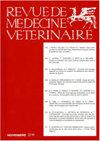19世纪赫雷斯·德洛斯·卡瓦耶罗斯(西班牙巴达约斯)的兽医头衔
Q2 Veterinary
引用次数: 0
摘要
在整个19世纪的西班牙,兽医有不同的名字:兽医外科医生、蹄匠、阉割者、元帅等,直到20世纪,他们才得到专业和社会的认可。1850年,他们被赋予了卫生和动物技术的责任,尽管他们中的许多人继续练习踢马。随着兽医学校的建立,西班牙建立了现代兽医的基础;这对于公共卫生问题具有特别重要的意义,特别是对于像副兽医和肉类检查员这样的人员,因为他们试图了解动物疾病对食用动物肉的人口的影响。通过对赫雷斯·德洛斯·卡瓦耶罗斯(西班牙巴达霍斯)历史档案的研究,可以分析19世纪兽医专业人员如何在那里生活和工作,他们如何定居或离开这座城市,他们如何治疗供人类食用的动物流行病,以及他们如何承受当时和这座城市的经济困难。由于部分档案遭到破坏和丢失,很难获得更多的资料。本文章由计算机程序翻译,如有差异,请以英文原文为准。
Los veterinarios titulares de Jerez de los Caballeros (Badajoz, España) durante el siglo XIX
Veterinarians had different names throughout the 19th century in Spain: veterinary surgeons, farriers, castrators, marshals, etc., and they were not professionally and socially recognized until the 20th century. In 1850 they were given sanitary and zootechnical responsibilities, although many of them continued practicing horse shodding. With the creation of veterinary schools, the foundations of modern veterinary medicine were established in Spain; this has a special importance for public health issues, especially regarding figures like deputy veterinary and meat inspector, as they tried to understand the impact of animal diseases on the population who consumed animal meat. Studies in the Historical Archives of Jerez de los Caballeros (Badajoz, Spain) made it possible to analyze how veterinary professionals lived and worked there during the 19th century, how they settled in or left the city, how they treated epidemics in animals for human consumption, and how they suffered the economic difficulties of the period and the City. The destruction and loss of part of the Archives makes it difficult to obtain more data.
求助全文
通过发布文献求助,成功后即可免费获取论文全文。
去求助
来源期刊

Revue De Medecine Veterinaire
农林科学-兽医学
CiteScore
1.30
自引率
0.00%
发文量
0
审稿时长
18-36 weeks
期刊介绍:
The Revue de Médecine Vétérinaire publishes four kinds of text:
1) Scientific reviews on subjects related to veterinary and comparative medicine. Suggested length: 10 to 30 typed pages.
2) Original reports on fundamental or applied research. Suggested length: 10 to 15 typed pages.
3) Continuous education articles, that should be easily understandable by non-specialists. Suggested length: 10 to 15 typed pages.
4) Clinical reports. Suggested length: 5 to 15 typed pages.
The publication can be done in French language or English language.
For an article written in English by not english native speakers authors, the manuscript must be subjected by attesting that it was read again by an anglophone scientist or a scientific translator.
The authors must certify that the manuscript was not published or subjected for publication to another review.
The manuscript must be accompanied by a sheet signed by all the joint authors indicating their agreement for the tender of the manuscript.
The publication is free but a financial participation could be required for the photographs color. An estimate will be sent to collect the agreement of the authors.
 求助内容:
求助内容: 应助结果提醒方式:
应助结果提醒方式:


